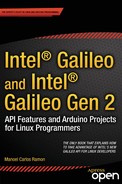Contents
![]() Chapter 1: Intel Galileo and Intel Galileo Gen 2
Chapter 1: Intel Galileo and Intel Galileo Gen 2
The Processor: Intel Quark SoC X1000
Introducing Intel Galileo Gen 2
The Serial Cable for Intel Galileo
The Serial Cable for Intel Galileo Gen 2
Introduction to the Yocto Build System
Creating Your Own Intel Galileo Images
Building and Using the Cross-Compiler Toolchain
Booting Intel Galileo with Your Own Images
What to Do If Intel Galileo Bricks
![]() Chapter 3: Arduino IDE and Wiring Language
Chapter 3: Arduino IDE and Wiring Language
Installing the Arduino IDE for Intel Galileo
Installing the Drivers and the Arduino IDE
Checking the Port and Board Selected
Compiling and Running the Sketch
Persisted and Not Persisted Sketches
Persisted Sketches and Long Time to Start
Debugging with Serial Console and Serial Communication
Printing Debug Messages and Using the Serial Console
The Arduino Language Reference and APIs
Updating the Firmware Using the IDE
Updating the Firmware with Different Firmware
Serial Communication Issues with IDE on Windows
IDE Problems with Virtual Machines and 64-Bit Linux
Communicating Sketches with Linux Native Programs
is.Additionalfuture Project Example: Unread Email Alarm with Python and POSIX Functions
The Mistake with Intel Galileo and Servos
Serial, Serial1, and Serial2 Objects
Testing the Serial, Serial1, and Serial2 Objects
unsigned long pulseIn(uint8_t pin, uint8_t state, unsigned long timeout = 1000000)
Hacking the GPIO Expander for New PWM Frequencies
Single Code for Intel Galileo and Intel Galileo Gen 2
Project: DHT Sensor Library with Fast I/O APIs
A Workaround Using Tri-State Buffers
Creating a New Library for DHT11 Sensor
![]() Chapter 5: Networking and Hacks
Chapter 5: Networking and Hacks
Setting Up the WiFi Mini-PCIe Card
Checking if the WiFi Card Was Recognized
Adding Support to a New WiFi Card
Scanning the Wireless Networks
Step 1: Setting Up the WiFi Connection
Step 2: Restart the Wireless Connection
Step 3: Hacking the WiFi Class
What’s New with Ethernet API and Intel Galileo
Ethernet Example: Network Time Protocol (NTP)
Dynamic and Static IP Using Ethernet
Simplifying the Sketches by Removing the Ethernet Objects
Transferring Files Between Intel Galileo and Computers
Hacking the IDE to Improve the Sketch Transfer
![]() Chapter 6: Tweeting with REST API 1.1
Chapter 6: Tweeting with REST API 1.1
Workaround with 1.5V Batteries
Creating a Twitter Application Account
Step 1: Creating Your Twitter Account
Step 2: Creating the Twitter Application
Creating a Script to Post Messages on Twitter
Step 2: Generating the OAuth Signature with the OAuth Tool
Step 3: Creating a Script to Post on Twitter with Intel Galileo
Step 4: Creating a Sketch that Tweets
Ideas for Improving the Project
Flowers and Plants Communicating with You on a Social Network
Preparing the BSP Software Image and Toolchain
Using eGlibc for Video4Linux Image
Disabling GPU Support on OpenCV
Building the SD Image and Toolchain
Exploring the Webcam Capabilities with V4L2-CTL
Changing and Reading Camera Properties
Capturing Videos and Images with libv4l2
Capturing an Image with OpenCV
The Same Software Written in Python
Ideas for Improving the Project
Integrating Your Emotions with a Robotic Head
Improving the Emotion Classification Using Large Databases
Improving the Emotion Classification for Several Faces
![]() Chapter 8: Creating a Soil Moisture Sensor
Chapter 8: Creating a Soil Moisture Sensor
Assembling the Moisture Sensors
Testing the Flower Face with the Software
Ideas for Improving the Project
Increasing the Number of Sensors
![]() Chapter 9: Home Automation and Dynamic Web
Chapter 9: Home Automation and Dynamic Web
Integrating the Components Individually
Testing the YwRobot Relay Module
Testing the TMP36 Temperature Sensor
Joining All Code in a Single Sketch
Creating Your Own Web Server with node.js
Running the Home Automation System
Ideas for Improving the Project
Changing the Web Page and Web Server Without Experience with the Web
Creating an Analogic Keypad and Having More I/Os Available
Adding a Username and Password
![]() Chapter 10: Power over Ethernet (PoE)
Chapter 10: Power over Ethernet (PoE)
Powering On with the PoE Injector
Ideas for Improving the Project
![]() Chapter 11: Assembling and Controlling a Robotic Arm
Chapter 11: Assembling and Controlling a Robotic Arm
An introduction to Robotic Arm Theory
Using an Online Tool to Calculate Your Servos
Considerations About This Project
Step 3: Assembling the Shoulder
Step 6: Assembling the Mechanical Gripper
Building a Servo Control Board
A Gripper Based on Coffee and a Balloon
A Sketch for the Coffee Gripper
Ideas for Improving this Project
![]() Chapter 12: Using an LTE Modem
Chapter 12: Using an LTE Modem
An Introduction to XMM7160 and XMM7260
Considerations Related to Antennas
Step 1: Preparing the SIM Card
Step 2: The NGFF/mPCIe Adaptor
Step 3: Adapting the Modem Card
Step 4: Connecting the Antennas
Step 5: Connecting the Modem to Intel Galileo
Step 2: Loading the CDC-ACM Driver
Step 3: Checking if the Modem Responds to AT Commands
Step 4: Checking the SIM Card Connection
Step 5: Configuring the APN and Attaching it to the Network
Step 6: Creating an IP Interface with pppd
Step 7: Testing the Internet Connection
Testing the Internet Bandwidth
Why Aren’t the Download/Upload Bandwidths Optimal?
Ideas for Improving the Project
Loading the cdc-acm Driver Automatically
![]() Appendix A: Intel Galileo I/O and Muxing
Appendix A: Intel Galileo I/O and Muxing
